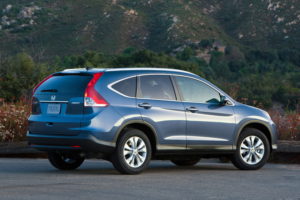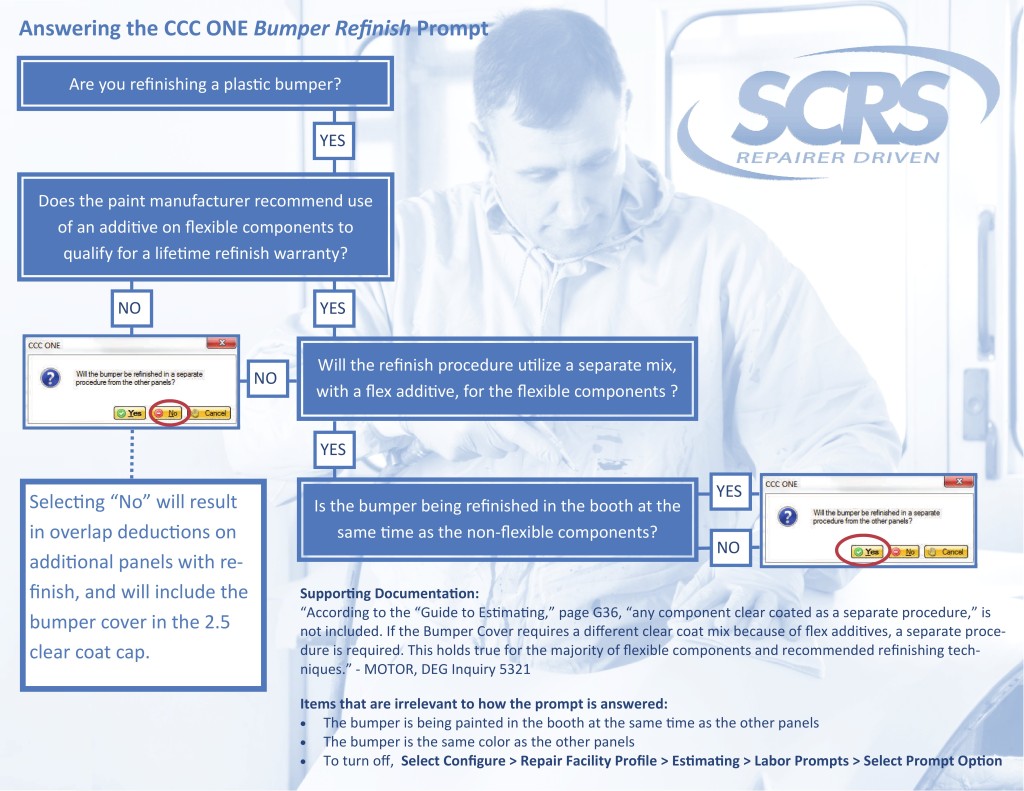
Answers to refinishing questions on CR-V edging, Camry bumper prompt: 5 more tips from the DEG
By onAssociations | Business Practices | Education | Repair Operations | Technology
The Database Enhancement Gateway, which allows repairers to make inquiries and suggestions of the Big 3 estimating providers, was augmented last year to offer weekly tips for repairers on the AudaExplore, Mitchell and CCC programs.
If you haven’t used the service before to submit questions about estimating collision repair work or just browse responses to other shops’ questions, check it out. It’s a good way to find IP best practices and help write the most accurate estimates or appraisals possible.
Here’s some recent areas spotlighted as tip-worthy by DEG; we round them up monthly for our readers. To receive the tips as soon as DEG releases them, like/follow DEG’s Facebook and Twitter feeds; it posts videos to a YouTube channel once in a while.
Don’t forget different times for recycled parts
If you’re installing a recycled part on a vehicle, don’t forget to use the correct estimating methodology.
Typical p-pages refer to about the most ideal set of conditions possible. CCC and Mitchell both note that their times specifically refer to an work on an undamaged, factory floor model and installing new OEM parts. AudaExplore’s times also refer to brand-new OEM parts, though it’s unclear what condition of vehicle they’re assuming.
“When replacing a component with a used part it is important that you follow the recycled estimating guide for your system or you will likely not be capturing necessary labor items that are associated with the use of used parts,” the DEG wrote.
- For CCC, consult the RACED guide.
- For AudaExplore, included and non-included procedures appear in the Audatex Database Reference Manual.
- Mitchell doesn’t produce another guide, but the necessary information appears within the system itself, according to the DEG.
How the estimating systems indicate changes
As implied above, the estimating systems assume you’ll have to adjust items to reflect conditions in the field. All three use a single or double asterisk (*) or (**) to tell viewers that an “included” line item has been changed.
AudaExplore uses a single * on estimates to indicate “User-Entered Value,” according to the DEG.
For CCC, * or ** on an estimate “indicates that the parts and/or labor data provided by third party sources of data may have been modified or may have come from an alternate data source,” the DEG noted.
For Mitchell, an * means “Judgment item,” according to the DEG.
Bumper prompt
The DEG advises repairers to think about the refinishing process planned for the part when figuring out what to answer on the CCC “bumper prompt,” which asks “Will the bumper be refinished in a separate procedure from the other panels?”
“When selecting the bumper prompt option in CCC One it is important to consider how the bumper will be refinished,” the DEG wrote, providing the example of when “you are painting the bumper cover with the vehicle BUT you need to add a flex to a different clear coat mix.”
It referenced CCC’s answer to a 2012 inquiry.
Page G36 of CCC’s guide states “‘any component clear coated as a separate procedure,’ is not included,” the IP wrote in response to a question involving a 2010 Toyota Camry. “If the Bumper Cover requires a different clear coat mix because of flex additives, a separate procedure is required. This holds true for the majority of flexible components and recommended refinishing techniques.”
CCC offered a few exceptions then:
“However, some paints have flex additives built into the paint mix,” it wrote. “Some types of Bumper Covers do not require flex additives. Additionally, some repairers choose to refinish components that do not require flex additives in a single, continuous procedure along with the Bumper Cover.”
“The answer is dependent on the paint, the component, OEM procedures, paint manufacturer recommendations, and the repairers approach to refinishing the Bumper Cover.”
It’s all dependent on the situation, and the Society of Collision Repair Specialists has provided a helpful guide to making the decision and avoid cycle time-wasting arguments between the shop and adjustor. Get it here.
The 2012 inquiry arose from a user who’d asked the DEG to settle a dispute with Allstate over the right answer to the bumper prompt regarding the 2010 Camry.
“Allstate has taken the position that the answer should be no,” the user wrote.
“This is a .6 refinish deduction and a .2 major overlap deduction on all Allstate bumper claims if any other part or area of the car is being refinished,” the user wrote. “With material allowance deduction depending on labor rates (it’s) about $60 deduction per repair, This is on ALL makes and models.”
“I contacted CCC and they say Allstate is wrong, the question is basicly on or off the car.”
‘Edging’ on CCC, AudaExplore
If you’re refinishing the edge of a panel, don’t forget to select “edging” on CCC, the DEG advises. And then don’t forget to include the clear-coat too.
“Doing this allows for refinish of the edge but does not include clear coat for the edge,” the DEG wrote. “To add clear coat to the edge you must right click the ‘Add for Edging’ line of the estimate then select clear coat. This would be for most any panel that allows the user to edge.”
CCC has stressed in response to a related April inquiry about a 2013 Honda CR-V that a user must have applied the April 15 database update to get that edge-clearcoat option.
“If I select a door outer panel for replacement, I am given an option of ‘Add for Edging’ and ‘Add for Edging Clearcoat’,” the user wrote. “If I select to *repair* the door panel, and select the edging/inside checkbox(s), I am not given the option to clearcoat the edging/inside. How do I get that option (edging clearcoat) on a repaired panel?”
CCC described the same steps as the DEG did, but preceded it with a note advising the user to check their version — good advice for any software user.
“When tested against the most recent electronic delivery of CCC ONE Estimating, when repairing the Front or Rear Door Outer Panels the Clear Coat time is added for Edging when selected to the estimate and there is no need to select manually,” CCC wrote then. “The most current version of the database has a 4/15/2016 date. Select Estimate Properties on the Estimate tab to confirm your database version. If the version is incorrect, please contact CCC Technical Support at 800-637-8511.”
NOTE: By the time you read this, the database might have received another update; the April 15th version might not be the most current. Check with CCC if you’re unsure if your system is up-to-date.
And speaking of updates, AudaExplore has one coming in June which should address another edging issue experienced with a 2013 Mazda 3.
Non-included color-related operations in Mitchell
Mixing toners isn’t included when preparing a refinishing estimate in Mitchell, the DEG noted. Neither are some other refinishing procedures, according to the Mitchell answer referenced in the tip.
A user with a 2015 Jeep Cherokee asked the IP a couple of paint-related questions in April:
“Is mixing the individual toners to create the vehicle color an included operation?” the user wrote.
“Is the time to determine the correct color variation an included operations?
“The color variation could be determined with different methods. One includes manually pulling the chip variations, buff a spot on the vehicle then compare the chip to the vehicle and see which variation is best. Another process would be to purchase a tool that reads the paint color variations. Would these two procedures be included with anything in the refinish process?”
No and no, Mitchell replied.
“Mixing individual toners from a mixing bank per a formula to create a quantity of paint for a specific paint color or code is not included in any published Mitchell labor time,” Mitchell wrote.
“Determining the correct variant of a specific paint code by utilizing variant card decks or by using an automated tool that examines the color of the vehicle finish to arrive at a correct formulation to mix toners to create a quantity of paint of a specific color is not included in any Mitchell refinish time.
“Please reference ‘Color match or tinting’ from the Not Included Operations of the Refinish Procedure from the Mitchell P-pages.”
Have a question?
Have a question about AudaExplore, Mitchell or CCC? Submit inquiries to the DEG here.

